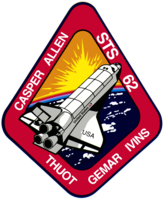STS-62
 | |
| Dane misji | |
| Indeks COSPAR | 1994-015A |
|---|---|
| Zaangażowani | |
| Oznaczenie kodowe | STS-62 |
| Pojazd | |
| Wahadłowiec | Columbia |
| Załoga | |
 Od lewej: Charles Gemar, Andrew Allen, Marsha Ivins, John Casper, Pierre Thuot | |
| Dowódca | John Casper |
| Start | |
| Miejsce startu | Stany Zjednoczone, KSC, LC39-B |
| Początek misji | 4 marca 1994 13:53:00 UTC |
| Orbita okołoziemska | |
| Apogeum | 302 km |
| Lądowanie | |
| Miejsce lądowania | KSC, Pas startowy 33 |
| Lądowanie | 18 marca 1994 13:09:41 UTC |
| Czas trwania misji | 13 dni, 23 godz, 16 min, 41 sek |
| Przebyta odległość | 9 366 617 km |
| Liczba okrążeń Ziemi | 224[1] |
| Program lotów wahadłowców | |
STS-62 (ang. Space Transportation System) – szesnasta misja wahadłowca kosmicznego Columbia i sześćdziesiąta pierwsza programu lotów wahadłowców[2].
Załoga
- źródło[2]
- John Casper (3), dowódca (CDR)
- Andrew Allen (2), pilot (PLT)
- Pierre Thuot (3), specjalista misji 1 (MS1)
- Charles "Sam" Gemar (3), specjalista misji 2 (MS2)
- Marsha Ivins (3), specjalista misji 3 (MS3)
(liczba w nawiasie oznacza liczbę lotów odbytych przez każdego z astronautów)
Parametry misji
- Masa:
- startowa orbitera: – kg
- lądującego orbitera: 102 861 kg
- ładunku: 8759 kg
- Perygeum: 246 km[1]
- Apogeum: 309 km[1]
- Inklinacja: 39,0°[1]
- Okres orbitalny: 90,4 min[1]
Cel misji
Eksperymenty z zestawem przyrządów USMP-2 (United States Microgravity Payload) i OAST-2 (Office of Aeronautics and Space Technology)[2].
Zobacz też
Przypisy
Linki zewnętrzne
- podsumowanie misji STS-62 na stronie KSC (ang.)
- Mark Wade: STS-62 (ang.). W: Encyclopedia Astronautica [on-line]. [dostęp 2017-07-25].
- Spaceflight mission report: STS-62 (ang.). Spacefacts. [dostęp 2017-07-25].
Media użyte na tej stronie
The flag of Navassa Island is simply the United States flag. It does not have a "local" flag or "unofficial" flag; it is an uninhabited island. The version with a profile view was based on Flags of the World and as a fictional design has no status warranting a place on any Wiki. It was made up by a random person with no connection to the island, it has never flown on the island, and it has never received any sort of recognition or validation by any authority. The person quoted on that page has no authority to bestow a flag, "unofficial" or otherwise, on the island.
Astronauts included in the STS-62 crew portrait include (standing left to right) mission specialists Charles D. Gemar, Marsha S. Ivins, and Pierre J. Thuot. Seated left to right are Andrew M. Allen, pilot; and John H. Casper, commander. Launched aboard the Space Shuttle Columbia on March 4, 1994 at 8:53:00 am (EST), the STS-62 mission carried two primary payloads; the U.S Microgravity Payload-2 (USMP-2) and the Office of Aeronautics and Space Technology-2 (OAST-2).
STS-62 Mission Insignia


